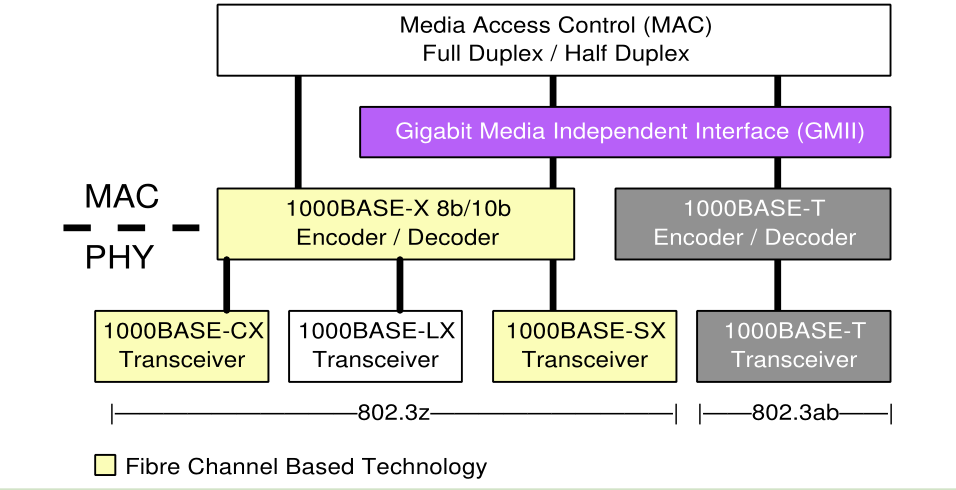Since the launch of national Specification of Gigabit Ethernet Switches Devices Technology, the application of Gigabit Ethernet technology has developed quickly. Due to the following reasons, 1000BASE-T, achieving Gigabit Ethernet over Category 5 (cat.5) twisted pairs, becomes one of the best choices for network managers. First, it meets the increasing demand of higher bandwidth. Second, new application emerges every day, while the amount of edge switches is increasing. Gigabit Ethernet can protect the existing devices, like Ethernet and Fast Ethernet, of a company. Third, it can provide a easy, effective and low-cost upgrading approach, meanwhile,it will allow them to use their existing copper cable plant, and the cost-of-entry for copper solutions has traditionally been lower than fiber-based solutions.
Gigabit Ethernet network utilizes the existing cable devices to achieve a network with a higher level. So it is featured with a good cost-performance ratio. It is applied between the floors, or inside a building, or inside a park, for 1000BASE-T can support various connectivity over a large area. Gigabit Ethernet works on the following four medias: fiber (max transmission distance is at least 5km), mode fiber (max distance is at least 550m), Twisted Pair (max distance is at least 25m); cat.5 fiber (max distance is at least 100m).
In June 1998, the standard of Gigabit Ethernet — IEEE 802.3z was approved, defining three kinds of transceivers as the transmission media. They are 1000Base-LX, 1000Base-SX and 1000Base-CX. (The following picture shows the relationship of the various members of the Gigabit Ethernet technology family.) 1000Base-LX is usually used with singlemode fiber (SMF). 1000Base-SX is applied to multimode fiber (MMF). 1000Base-CX is used with unshielded twisted pair (UTP), which is usually applied to the connections between machine rooms. 1000Base-LX transceiver can also be used with MMF. It can support at least 550-meter transmission over MMF. Another standard 802.3ab task force is working to standardize a Gigabit Ethernet link of 100 meters maximum length on four pairs of Category 5 UTP cabling.

In June 1999, IEEE Standards Association approved the standard of 1000Base-T. 1000Base-T can utilizes existing cable devices, supporting around 100m over Cat.5. Some specifications of 1000Base-T make it a low-cost, hard to be disrupted and high-performance technology. First, it supports Ethernet MAC, and can be compatible with 10/100Mbps Ethernet technology. Second, many 1000Base-T products support 100/1000 auto-negotiation, so that 1000Base-T can be achieved through rapid upgrade. Third, 1000Base-T technology has good performance. For example, it transmits every 10-billion-bit data with no more than one wrong data.
Category 5 cabling as defined by ANSI/TIA/EIA-568-A is currently the most commonly used data grade cabling in the US. A recent Sage study indicated that more than 72 percent of their sample of network installations reported having Category 5 cabling installed. 1000BASE-T is intended to provide a Gigabit Ethernet solution for these legacy networks. Accordingly, the Project Authorization Request (PAR) for the 1000BASE-T project specifically requires operation on four pair, 100 ohm Category 5 balanced copper cabling as defined by ANSI/TIA/EIA-568-A, or its equivalent as built from material specified by ISO/IEC 11801:1995 that meets the channel performance parameters specified in ANSI/TIA/EIA-568-AANNEX E. (There is currently a proposal to add a Category 5 channel specification to ISO/IEC 11801 that would provide the same channel performance parameters specified in ANSI/TIA/EIA-568-A.)
1000Base-T defines its transmission media as Cat.5 UTP. There are some other standards of 1000Base-T. ANSI/EIA/TIA-568-A(1995) defines the performance of its four pairs of cat.5. TIA/EIA-TSB-95 defines other parameters of performance (e.g. Return loss and ELFEXT). ISO/IEC 11801 clauses 6, 8 & 9 also have standardized FEXT (ELFEXT) loss and return loss for 1000Base-T. Standards such as EN50082-1 and IEC 1000-4-3 (IEC 801-3 Level 2) specify a required tolerance to a 3 V/m continuous wave source above 27MHz
The characteristics of Category 5 cabling and the regulatory constraints identified above create a significant challenge in defining the 1000 Mb/s physical layer. Fortunately, digital communications techniques developed in recent years can be used to design robust transceivers that are capable of achieving reliable operations in a Category 5 cabling environment. 1000BASE-T takes advantage of several of these techniques to transform the desired bit rate into an acceptable baud rate (signaling events per second) for operation over 4-pair Category 5 cabling.
- Use existing 4-pair Category 5 cable. To ensure proper operation at full link lengths, the cable must conform to the requirements of ANSI/TIA/EIA-568-A (1995).
- Use all four pairs in the cable to keep symbol rate at or below 125 Mbaud.
- Use PAM-5 coding to increase the amount of information sent with each symbol.
- Use 4D 8-state Trellis Forward Error Correction coding to offset the impact of noise and crosstalk.
- Use pulse shaping techniques to condition the transmitted spectrum.
- Use state-of-the-art DSP signal equalization techniques to manage the problems of noise, echo and crosstalk interferences, and to ensure a bit error rate of 10-10.
As more and more workgroups upgrade to Fast Ethernet, intensive business of backbone network will increase quickly. In order to handle this, all the new backbone switches should support Gigabit Ethernet uplink. Some Gigabit Ethernet switches of backbone network are used to connect servers with high transaction rate. Gigabit Ethernet gives the solution to high-speed connection between buildings. Then, 1000Base-T Gigabit Ethernet technology provide high-speed transmission between floors, even offices. This reliable Gigabit Ethernet over copper is both feasible and practical.




